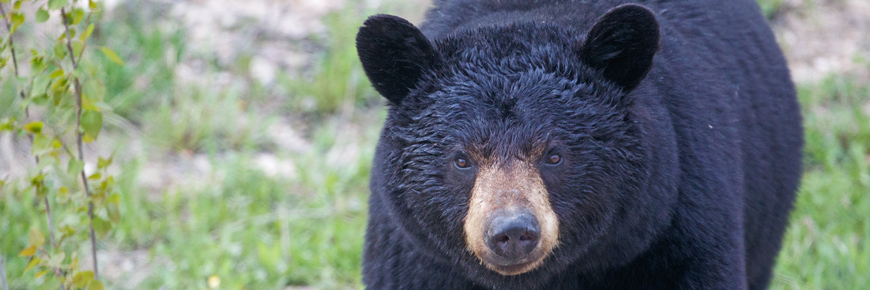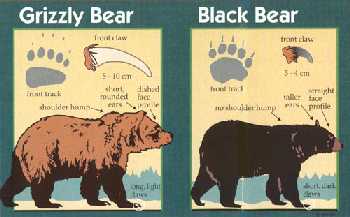
A Guide to Safety
National Parks introduce visitors to a landscape that is uniquely Canadian. But these parks are more than scenic wonderlands. They are home to many animals that depend on wilderness areas for their survival. For some, like the grizzly bear, national parks may be the critical core of a territory that can extend far beyond the park boundaries.
- You surprise them.
- They are protecting young or food.
- They follow food and food-like odours to you.
- Your dog provokes an attack.
- The bear you encounter is habituated to people and has lost its natural fear.
Why bears do what they do
Bear attacks are uncommon. Wild animals generally prefer to avoid people and bears are no exception. Most encounters between bears and people occur when the bear’s natural avoidance behaviour shifts to aggression because of the following factors:
The following guidelines to safety in bear habitat are just that–guidelines. Bear behaviour is hard to predict because they are complex animals. Each bear is an individual with the potential to react differently in different situations. The information that follows will give you some basics on how to avoid an encounter in the first place and guidance on how to react should one occur.
Research indicates that bear spray can be effective with some bears when used properly. If you plan to carry it, be aware that wind, spray distance, rain, freezing temperatures and product shelf life can all influence its effectiveness. Familiarize yourself with the proper use of bear spray (including the manufacturer’s specific instructions) and keep it readily accessible. Bear Spray
Travel as part of a group if possible and never let children wander.
Watch for fresh bear sign. Tracks, droppings, diggings, torn-up logs, turned-over rocks are all signs that a bear has been in the area. Leave the area if the signs are fresh. Never approach a bear. (Always maintain a distance of at least 100 metres). Keep your dog on a leash at all times or leave it at home. Dogs can provoke defensive behaviour in bears. Keep food and smells away from bears by properly storing food, garbage and food related items in bear resistant food containers, day and night, where ever you are. If you come across large dead animals, leave the area immediately and report it to Park Staff. AVOIDING an encounter
Subsistence harvest of wildlife by local Indigenous persons is conducted in northern National Parks. Bears may
be attracted to wildlife remains. All wildlife remains should be reported to Park staff. For safety reasons, Parks
Canada will share this information with visitors and Nahanni Butte Dene Band.
Dispose of fish offal in fast moving streams or the deep part of a lake, never along stream sides or lake shores.
Area Closures - for the safety of you and the bears, obey all area closures. Plan alternatives in case of a closure.
Your speed and quietness put you at risk for sudden encounters. Make noise, stay alert, slow down.

© CWI
Handling an ENCOUNTER
Stay calm and don't alarm the bear with screams or sudden movements. Remain still, stand your ground & assess the situation. Your calm behaviour can reassure it. Bears may bluff their way out of an encounter by charging and then turning away at the last second. Bears may also react defensively by “woofing”, growling, snapping their jaws, and laying their ears back. It’s difficult but important to remain calm if a bear reacts to you this way. A scream or sudden movement may trigger an attack.
Get your bear spray ready.
Speak to the bear. Let the bear hear your voice–talk calmly and firmly. This lets the bear know you are human and not a prey animal. If a bear rears on its hind legs and waves its nose about, it is trying to identify you.
Back away slowly when the bear is stationary, NEVER run! Running may trigger a pursuit and bears can run as fast as a racehorse, both uphill and downhill.
Make yourself less vulnerable – pick up small children and stay in a group.
Don't drop your pack. It can provide protection.
Leave the area or take a detour. If this is impossible, wait until the bear moves away. Always leave the bear an escape route.
Handling an ATTACK.
Most encounters with bears end without injury. If a bear actually makes contact, you may increase your chances of survival by following these guidelines. In general, there are 2 kinds of attack:
1. DEFENSIVE
What is the bear’s behaviour?The bear is feeding, protecting its young and/or unaware of your presence. It attacks because it sees you as a threat.
Use bear spray.
If the bear makes contact with you: PLAY DEAD!
PLAY DEAD. Lie on your stomach with legs apart and position your arms so that your hands are crossed behind your neck. This position makes you less vulnerable to being flipped over and protects your face, the back of your head and neck. Remain still until you are sure the bear has left the area.
These defensive attacks are generally less than two minutes in duration. If the attack continues, it may mean the attack has shifted from defensive to predatory–fight back!
Bottom line? It is very difficult to predict the best strategy to use in the event of a bear attack. That is why it is so important to put thought and energy into avoiding an encounter in the first place.
2. PREDATORY
What is the bear's behaviour?The bear is stalking (hunting) you along a trail and then attacks. Or, the bear attacks you at night.
Try to escape into a building, car or up a tree.
DON’T PLAY DEAD. If you can’t escape, use bear spray and fight back!
FIGHT BACK! Intimidate that bear: shout; hit it with a branch or rock, do whatever it takes to let the bear know you are not easy prey. This kind of attack is very rare but it is serious because it usually means the bear is looking for food and preying on you.
Backcountry Camping
To stay safe and protect wilderness, travel with two goals in mind: limiting your impact by avoiding encounters and managing your food, food smells and garbage.
Camp in designated areas where provided. Avoid camping near running water, thick brush, animal trails or berry patches.
Keep yourself and campsite odour free – set up cooking, eating and food storage areas at least 100 metres from your tent and consider wind direction. Keep sleeping bags, tents and sleeping clothes free of food, food odours or beverages.
Leave smelly cosmetics at home – Store toiletries and personal items with food.
Use bear-resistant storage containers that provide for food and garbage storage. Food canisters are mandatory in some northern national parks for overnight backcountry trips.
Store your food, pet food, livestock feed and garbage away from your tent. Hang between two trees at least 4 metres above the ground and 1.3 metres from top and side supports.
Wash and store all dishes and food utensils immediately after use. Strain food particles from dish water and store with garbage. Dump dishwater in designated areas or at least 100 metres from your sleeping area.
Pack out garbage – do not burn or bury it. Same storage as food.
Bear Resistant Food Canisters
Are recommended for overnight backcountry trips in many parks. In Nahanni National Park Reserve they are mandatory for overnight backcountry trips on many trails. Check with park staff before your trip.
Visitor Centre staff can provide information on current bear activity, closures, warnings and safety advice.
Report all sightings to park staff- Date modified :